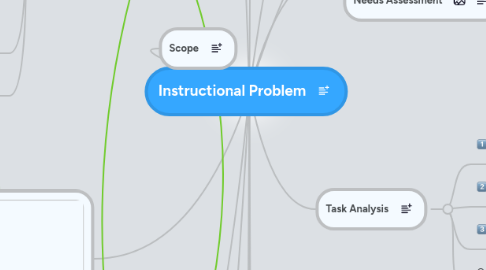
1. Cognitive Load Theory
1.1. Intrinsic Load
1.2. Extrinsic Load
1.3. Germane Load
1.4. Goal Free Effect
1.5. Worked-Example Effect
1.6. Split-Attention Effect
1.7. Redundancy
2. Instructional Designer
2.1. ID Influencers
2.1.1. SME
2.1.2. Evaluator
2.1.2.1. Evaluation
2.1.3. Learners
2.1.3.1. Learner Analysis
2.1.4. ADDIE
2.1.5. Objectives
2.1.6. Project Agreement
2.1.7. Legal Considerations
2.2. Methods
2.3. Mayer's Principles
2.4. Project Management
3. Contextual Analysis
3.1. Contextual Levels
3.1.1. Transfer Context
3.1.2. Instructional Context
3.1.2.1. Instructional Conditions
3.1.3. Orienting Context
3.2. Contextual Factors
3.2.1. Learner Factors
3.2.2. Immediate Environmental Factors
3.2.3. Organizational Factors
4. Instructional Theory
5. Evaluation
5.1. Formative
5.2. Summative
5.3. Confirmative
5.4. Validity
5.5. Reliability
5.6. Relative Standards
5.7. Absolute Standards
6. Scope
7. Needs Assessment
7.1. Normative Needs
7.2. Comparative Needs
7.3. Felt Needs
7.4. Expressed Needs
7.5. Anticipated Needs
7.6. Critical Incident Needs
8. Goal Analysis
9. Performance Assessment
10. Task Analysis
10.1. Topic Analysis
10.2. Content Structures
10.3. Procedural Analysis
10.4. Conditions of Learning
10.4.1. Events of Instruction
11. Instructional Objectives
11.1. Cognitive Domain
11.1.1. Bloom's Taxonomy
11.1.1.1. Creating
11.1.1.2. Evaluating
11.1.1.3. Analyzing
11.1.1.4. Applying
11.1.1.5. Understanding
11.1.1.6. Remembering
11.2. Psychomotor Domain
11.2.1. Dave's Model
11.2.2. Simpson's Model
11.2.3. Harrow's Model
11.3. Affective Domain
11.3.1. Behavioral Learning Theory
11.3.2. Cognitive Dissonance Theory
11.3.3. Affective-Cognitive Consistancy
11.3.4. Social Judgment Theories
11.3.5. Social Learning Theory
11.3.6. Functional Theories
11.3.7. Krathwohl's Taxonomy
11.4. Instructional Strategies
11.4.1. Motivational Strategies
11.4.2. Initial Presentation Strategies
11.4.3. Generative Strategies
11.4.3.1. recall
11.4.3.2. Integration
11.4.3.3. Organizational
11.4.3.4. Elaboration
11.4.3.5. Pre-Instructional Strategies
12. Sequencing
12.1. Learning-Related Sequencing
12.1.1. 5 Student Learning Concepts
12.2. Concept-Related Sequencing
12.3. Elaboration Theory Sequencing
12.3.1. Content Expertise Sequencing
12.3.2. Task Experience Sequencing
12.4. World-Related Sequencing
12.4.1. Spatial Relations
12.4.2. Temporal Relations
12.4.3. Physical Attributes
